window Citroen C ZERO 2015 1.G Owner's Manual
[x] Cancel search | Manufacturer: CITROEN, Model Year: 2015, Model line: C ZERO, Model: Citroen C ZERO 2015 1.GPages: 176, PDF Size: 5.21 MB
Page 4 of 176
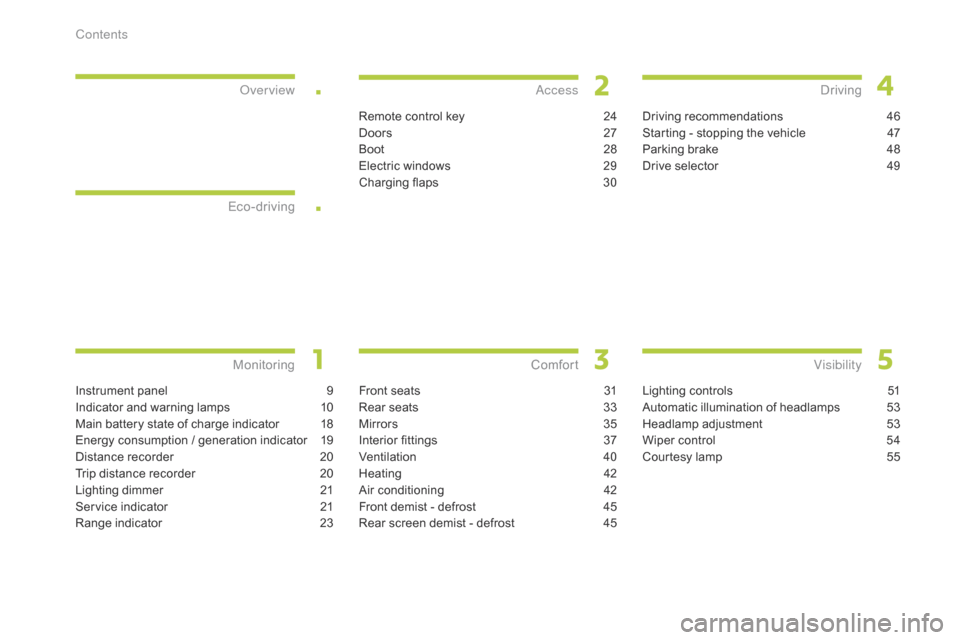
.
.
C-zero_en_Chap00a_sommaire_ed01-2014
Instrument panel 9
In dicator and warning lamps
10
M
ain battery state of charge indicator
18
E
nergy consumption
/ g
eneration indicator
19
D
istance recorder
20
T
rip distance recorder
20
L
ighting dimmer
21
S
ervice indicator
21
R
ange indicator
23
Monitoring
over
view
Eco-driving
Remote control key 24
D oors
27
Boo
t
28
E
lectric windows
29
C
harging flaps
30
access
Front seats 31
R ear seats
33
M
irrors
35
In
terior fittings
37
V
entilation
40
H
eating
42
A
ir conditioning
42
F
ront demist - defrost
45
R
ear screen demist - defrost
45
Comfort
Driving recommendations 46
S tarting - stopping the vehicle
47
P
arking brake
48
D
rive selector
49
Driving
Lighting controls 51
A utomatic illumination of headlamps
53
H
eadlamp adjustment
53
W
iper control
54
C
ourtesy lamp
55
Visibility
Contents
Page 8 of 176
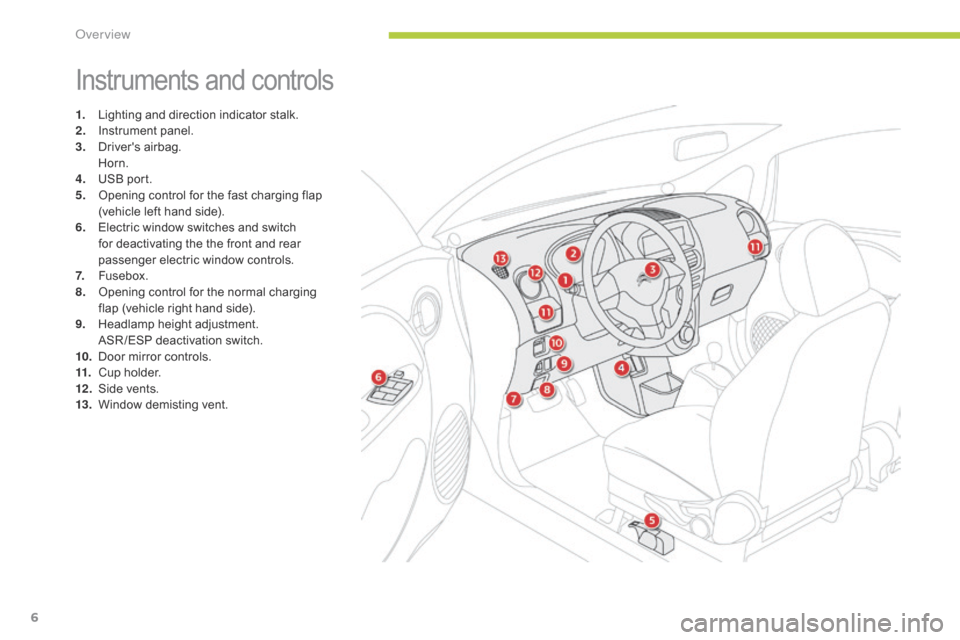
6
C-zero_en_Chap00b_vue-ensemble_ed01-2014
Instruments and controls
1. Lighting and direction indicator stalk.
2. In strument panel.
3.
Dr
iver's airbag.
Ho
rn.
4.
US
B port.
5.
Op
ening control for the fast charging flap
(vehicle left hand side).
6.
El
ectric window switches and switch
for deactivating the the front and rear
passenger electric window controls.
7.
Fus
ebox.
8.
Op
ening control for the normal charging
flap (vehicle right hand side).
9.
He
adlamp height adjustment.
AS
R /ESP deactivation switch.
10.
Do
or mirror controls.
11.
Cu
p holder.
12 .
Si
de vents.
13.
Wi
ndow demisting vent.
Over view
Page 10 of 176
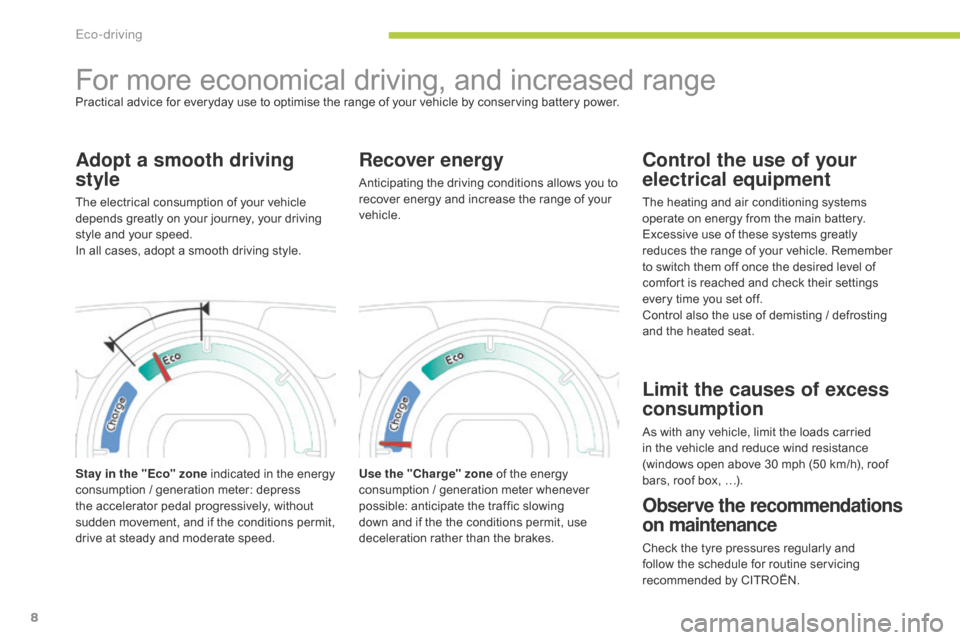
8
C-zero_en_Chap00c_Eco-conduite_ed01-2014
For more economical driving, and increased rangePractical advice for everyday use to optimise the range of your vehicle by conserving battery power.
Adopt a smooth driving
style
The electrical consumption of your vehicle
depends greatly on your journey, your driving
style and your speed.
In all cases, adopt a smooth driving style.
Stay in the "Eco" zone indicated in the energy
consumption
/ g
eneration meter: depress
the accelerator pedal progressively, without
sudden movement, and if the conditions permit,
drive at steady and moderate speed.
Recover energy
Anticipating the driving conditions allows you to
recover energy and increase the range of your
vehicle.
Use the "Charge" zone of the energy
consumption
/ g
eneration meter whenever
possible: anticipate the traffic slowing
down and if the the conditions permit, use
deceleration rather than the brakes.
Control the use of your
electrical equipment
The heating and air conditioning systems
operate on energy from the main battery.
Excessive use of these systems greatly
reduces the range of your vehicle. Remember
to switch them off once the desired level of
comfort is reached and check their settings
every time you set off.
Control also the use of demisting
/ d
efrosting
and the heated seat.
Limit the causes of excess
consumption
As with any vehicle, limit the loads carried
in the vehicle and reduce wind resistance
(windows open above 30 mph (50 km/h), roof
bars, roof box, …).
Observe the recommendations
on maintenance
Check the tyre pressures regularly and
follow the schedule for routine servicing
recommended by CITROËN.
Eco-driving
Page 31 of 176
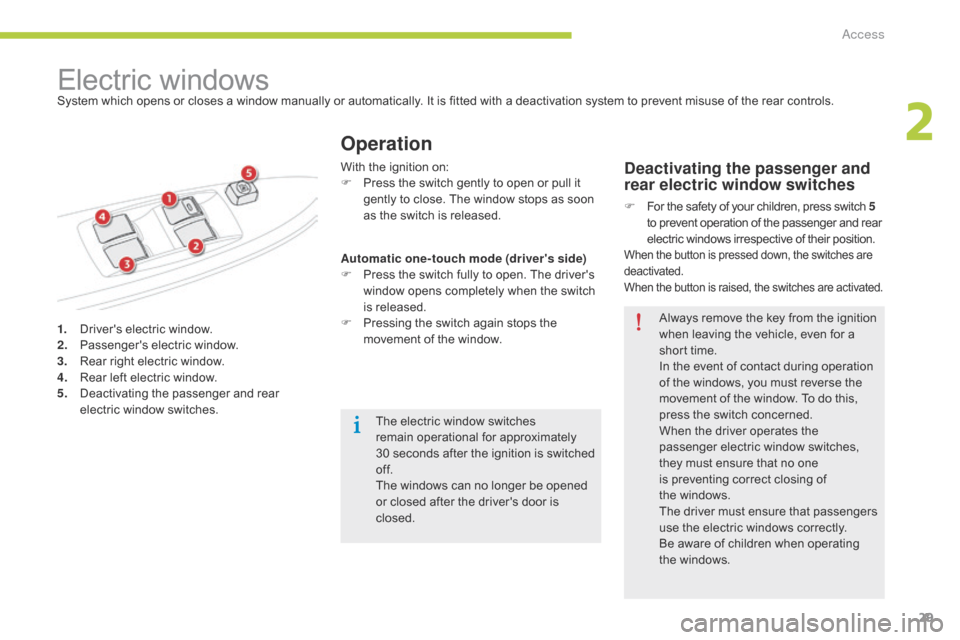
29
C-zero_en_Chap02_ouvertures_ed01-2014
1. Driver's electric window.
2. Pa ssenger's electric window.
3.
Re
ar right electric window.
4.
Re
ar left electric window.
5.
Dea
ctivating the passenger and rear
electric window switches.
Electric windows
Operation
Deactivating the passenger and
rear electric window switches
F For the safety of your children, press switch 5
to prevent operation of the passenger and rear
electric windows irrespective of their position.
When the button is pressed down, the switches are
deactivated.
When the button is raised, the switches are activated.
System which opens or closes a window manually or automatically. It is fitted with a deactivation system to prevent misuse of the rear controls.
The electric window switches
remain operational for approximately
30
s
econds after the ignition is switched
of f.
The windows can no longer be opened
or closed after the driver's door is
closed.
With the ignition on:
F
Pr
ess the switch gently to open or pull it
gently to close. The window stops as soon
as the switch is released.
Always remove the key from the ignition
when leaving the vehicle, even for a
short time.
In the event of contact during operation
of the windows, you must reverse the
movement of the window. To do this,
press the switch concerned.
When the driver operates the
passenger electric window switches,
they must ensure that no one
is preventing correct closing of
the
wi
ndows.
The driver must ensure that passengers
use the electric windows correctly.
Be aware of children when operating
the windows.
Automatic one-touch mode (driver's side)
F
Pr
ess the switch fully to open. The driver's
window opens completely when the switch
is released.
F
Pr
essing the switch again stops the
movement of the window.
2
Access
Page 42 of 176

40
C-zero_en_Chap03_confort_ed01-2014
Ventilation
Air intake
The air circulating in the passenger
compartment is filtered and originates either
from the outside via the grille located at the
base of the windscreen or from the inside in air
recirculation mode. System which creates and maintains good
conditions of comfort and visibility in the
vehicle's passenger compartment.
Controls
The incoming air follows various routes
depending on the controls selected.
The temperature control enables you to obtain
the level of comfort required by mixing the air of
the various circuits.
The air distribution control enables you to
select the air vents used in the passenger
compartment.
The air flow control enables you to increase or
reduce the speed of the ventilation fan.
These controls are grouped together on control
panel A on the centre console.
Air distribution
1. Windscreen demisting/defrosting vents.
2. Fr ont side window demisting/defrosting
vents.
3.
Si
de adjustable air vents. 4. Ce
ntral adjustable air vents.
5. Ai r outlets to the front footwells.
Comfort
Page 43 of 176
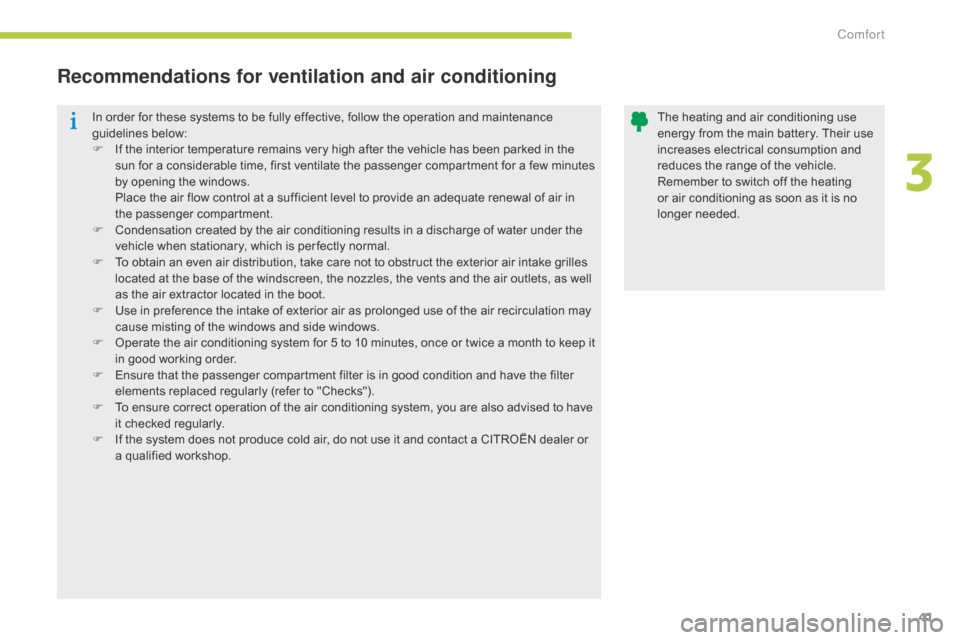
41
C-zero_en_Chap03_confort_ed01-2014
In order for these systems to be fully effective, follow the operation and maintenance
guidelines below:
F
If t
he interior temperature remains very high after the vehicle has been parked in the
sun for a considerable time, first ventilate the passenger compartment for a few minutes
by opening the windows.
Pl
ace the air flow control at a sufficient level to provide an adequate renewal of air in
the passenger compartment.
F
Co
ndensation created by the air conditioning results in a discharge of water under the
vehicle when stationary, which is per fectly normal.
F
To o
btain an even air distribution, take care not to obstruct the exterior air intake grilles
located at the base of the windscreen, the nozzles, the vents and the air outlets, as well
as the air extractor located in the boot.
F
Us
e in preference the intake of exterior air as prolonged use of the air recirculation may
cause misting of the windows and side windows.
F
Op
erate the air conditioning system for 5 to 10 minutes, once or twice a month to keep it
in good working order.
F
En
sure that the passenger compartment filter is in good condition and have the filter
elements replaced regularly (refer to "Checks").
F
To e
nsure correct operation of the air conditioning system, you are also advised to have
it checked regularly.
F
If t
he system does not produce cold air, do not use it and contact a CITROËN dealer or
a qualified workshop.
Recommendations for ventilation and air conditioning
The heating and air conditioning use
energy from the main battery. Their use
increases electrical consumption and
reduces the range of the vehicle.
Remember to switch off the heating
or air conditioning as soon as it is no
longer needed.
3
Comfort
Page 45 of 176

43
C-zero_en_Chap03_confort_ed01-2014
4. Air intake / Air recirculation
The intake of exterior air prevents the formation
of mist on the windscreen and side windows.
The recirculation of interior air isolates the
passenger compartment from exterior odours
and smoke.
Return to exterior air intake as soon as possible
to prevent deterioration of the the air quality
and the formation of mist.F
Pr
ess this button to recirculate
the interior air. The indicator
lamp comes on to confirm this.
F
Pr
ess the button again to
permit the intake of exterior air.
The
i
ndicator lamp switches off
to confirm this.
3. Air distribution adjustment
Place the dial in the desired
position to distribute air to:
central and side vents,
central, side and footwell vents,
footwells,
windscreen, side windows and
footwells,
windscreen and side windows.
The air distribution can be adapted by placing
the dial in an intermediate position. With the dial in the " AUTO" position, air
distribution is adjusted automatically,
according to the temperature selected.
2. Air flow adjustment
F Turn the dial to the
r ight to increase air
flow and to the left
to reduce it.
With the dial in the " AUTO" position,
the air flow is adjusted automatically,
according to the interior temperature.
3
Comfort
Page 46 of 176
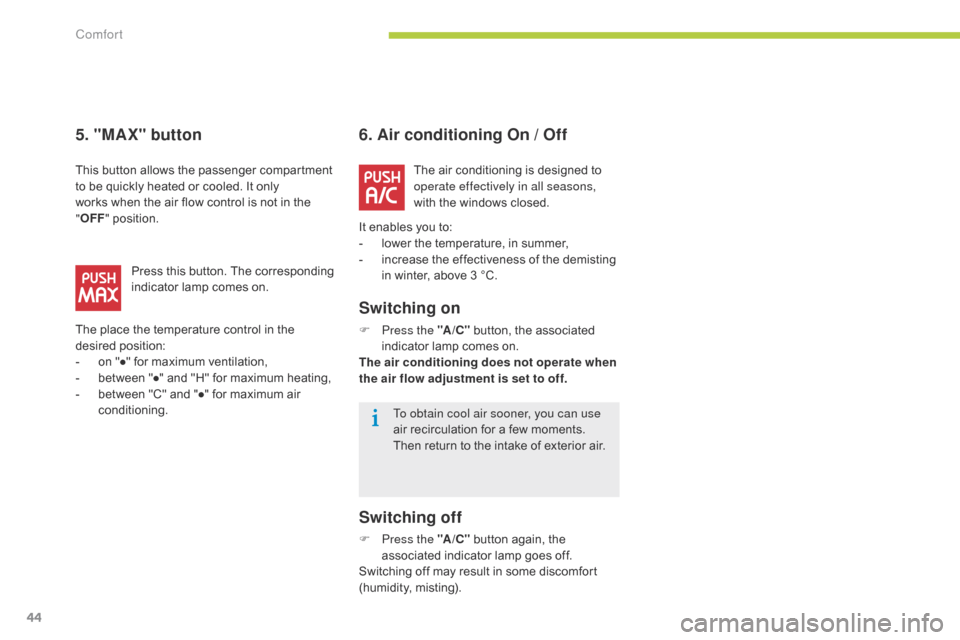
44
C-zero_en_Chap03_confort_ed01-2014
6. Air conditioning On / Off
Sw itching on
F Press the "A /C " b utton, the associated
indicator lamp comes on.
The air conditioning does not operate when
the air flow adjustment is set to off.
Switching off
F Press the "A /C " b utton again, the
associated indicator lamp goes off.
Switching off may result in some discomfort
(humidity, misting).
5. "MAX" button
The air conditioning is designed to
operate effectively in all seasons,
with the windows closed.
It enables you to:
-
lo
wer the temperature, in summer,
-
in
crease the effectiveness of the demisting
in winter, above 3 °C.
This button allows the passenger compartment
to be quickly heated or cooled. It only
works when the air flow control is not in the
"
OFF "
p
osition.
Press this button. The corresponding
indicator lamp comes on.
The place the temperature control in the
desired position:
-
on "
●" for maximum ventilation,
-
be
tween "●" and "H" for maximum heating,
-
be
tween "C" and "●" for maximum air
conditioning. To obtain cool air sooner, you can use
air recirculation for a few moments.
Then return to the intake of exterior air.
Comfort
Page 72 of 176

70
C-zero_en_Chap06_securite_ed01-2014
Lateral airbags
Deployment
A lateral airbag is deployed unilaterally in the
event of a serious side impact applied to all or
part of the side impact zone B, perpendicular
to the longitudinal centreline of the vehicle on a
horizontal plane and directed from the outside
towards the inside of the vehicle.
The lateral airbag inflates between the hip and
shoulder of the front occupant of the vehicle
and the corresponding door trim panel. System which protects the driver and front
passenger in the event of a serious side impact
in order to limit the risk of injury to the chest,
between the hip and the shoulder.
Each lateral airbag is fitted in the seat backrest
frame, door side.
Impact detection zones
A. Front impact zone.
B. Si de impact zone.
Curtain airbags
System which protects the driver and
passengers in the event of a serious side
impact in order to limit the risk of injury to
the
head
.
Each curtain airbag is fitted in the pillars
and the upper section of the passenger
compartment. In the event of a minor impact or bump
on the side of the vehicle or if the
vehicle rolls over, the airbag may not be
triggered.
In the event of a rear or front collision,
the airbag is not triggered.
Deployment
Each curtain airbag is deployed at the same
time as the corresponding lateral airbag in the
event of a serious side impact applied to all or
part of the side impact zone B, perpendicular
to the longitudinal centreline of the vehicle on a
horizontal plane and directed from the outside
towards the inside of the vehicle.
The curtain airbag inflates between the front or
rear occupant of the vehicle and the windows.
If this warning lamp comes on in
the instrument panel, contact a
CITROËN dealer or a qualified
workshop to have the system
checked. The airbags may no longer
be deployed in the event of a serious
impact.
Operating fault
Safety
Page 82 of 176

80
C-zero_en_Chap07_securite-enfants_ed01-2014
The incorrect installation of a child seat in a
vehicle compromises the child's protection
in the event of an accident.
Check that there is no seat belt or seat belt
buckle under the child seat as this could
destabilise it.
Remember to fasten the seat belts or the
child seat harnesses keeping the slack in
relation to the child's body to a minimum,
even for short journeys.
When installing a child seat using the seat
belt, check that the seat belt is tightened
correctly on the child seat and that it
secures the child seat firmly on the seat of
your vehicle.
at th
e rear seats, always leave sufficient
space between the front seat and:
-
a re
ar ward facing child seat,
-
th
e feet of a child seated in a for ward
facing child seat.
For this, move the front seat for ward and if
necessary straighten its backrest.
Advice on child seats
Children at the front
The legislation on carrying a child on the
front passenger seat is specific to each
c o unt r y.
Refer to the legislation in force in your
c o unt r y.
Deactivate the passenger's airbag when
a rear ward facing child seat is installed on
the front seat.
Other wise, the child would risk being
seriously injured or killed if the airbag were
deployed. For optimum installation of a for ward facing
child seat, ensure that the back of the
child seat is as close as possible to the
backrest of the vehicle's seat, or in contact
if possible.
The head restraint must be removed before
installing a child seat with a backrest on
the passenger seat. Ensure that the head
restraint is stowed or attached securely so
that it is not thrown around the vehicle in
the event of sharp braking.
Refit the head restraint as soon as the child
seat is removed.
Installing a booster seat
The chest part of the seat belt must be
positioned on the child's shoulder without
touching the neck.
Ensure that the lap part of the seat belt
passes correctly over the child's thighs.
CITROËN recommends the use of a
booster seat which has a back, fitted with a
seat belt guide at shoulder level.
As a safety precaution, do not leave:
-
on
e or more children alone and
unsupervised in a vehicle,
-
a ch
ild or an animal in a vehicle which
is exposed to the sun, with the windows
closed,
-
th
e keys within reach of children inside
the vehicle.
To prevent accidental opening of the doors,
use the "Child lock".
Take care not to open the rear windows by
more than one third.
To protect young children from the rays of
the sun, fit side blinds on the rear windows.
Child safety